Paddle Dryer vs Rotary Dryer: What’s the Difference?
Compare paddle dryer vs rotary dryer — learn the key differences, working principles, and which dryer suits your material for better efficiency and results.
10/15/20257 min read
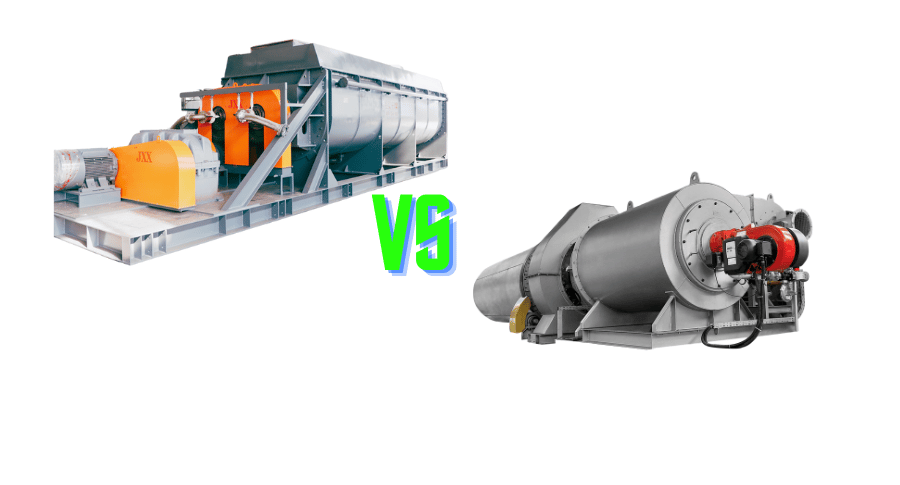

Choosing the right industrial dryer can significantly impact your product quality, energy consumption, and operating costs. Among the most popular technologies, paddle dryers and rotary dryers are widely used across chemical, environmental, and food industries — yet they work in very different ways. Understanding their key differences helps you make the best investment for your material and process.
A paddle dryer uses indirect heating through rotating paddles for controlled, energy-efficient drying of pastes and sludge.
A rotary dryer, in contrast, uses direct hot air for high-capacity drying of free-flowing solids.
Knowing which is better depends on your material characteristics, moisture content, and space constraints.
Before choosing between a paddle or rotary dryer, it’s essential to understand how each system works and what advantages they offer. Below is a clear, side-by-side comparison to help guide your decision.
1. What is a Paddle Dryer?
A paddle dryer is an indirect heating contact dryer that transfers heat through metal surfaces rather than hot air. Inside the machine, hollow rotating paddles gently mix and heat the material, ensuring uniform drying.
Because it doesn’t rely on air flow, the paddle dryer is perfect for sludge, pastes, filter cakes, and heat-sensitive materials. It offers precise temperature control, minimal emissions, and excellent energy efficiency.
Steam, thermal oil, or hot water circulates inside the paddle shafts and jacket. As the paddles rotate, the material moves slowly through the chamber while moisture evaporates. The result is a stable, closed drying process with low energy loss and clean exhaust.
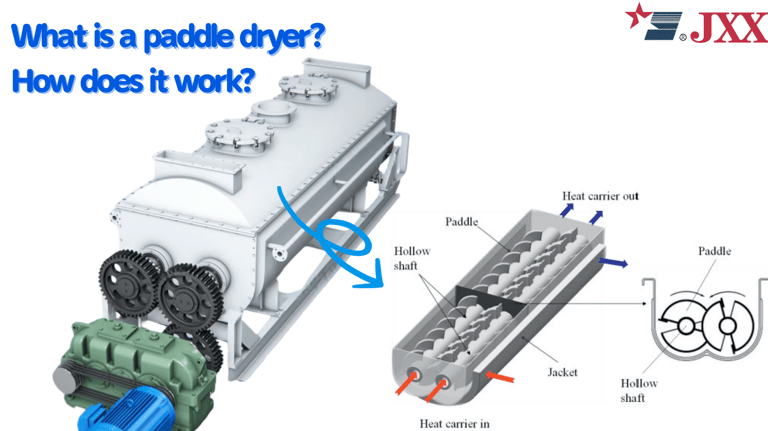

2.What is a Rotary Dryer?
A rotary dryer, or rotary drum dryer, is a direct heating system where hot air or flue gas contacts the material directly. The drum continuously rotates, lifting and cascading the particles through the air stream.
Rotary dryers are ideal for granular, free-flowing materials such as minerals, sand, and biomass. They are known for high throughput capacity and simple mechanical design.
Air temperature, flow rate, and drum rotation speed determine the drying efficiency. Although rotary dryers consume more energy than paddle dryers, they are highly effective for large-scale continuous drying operations.
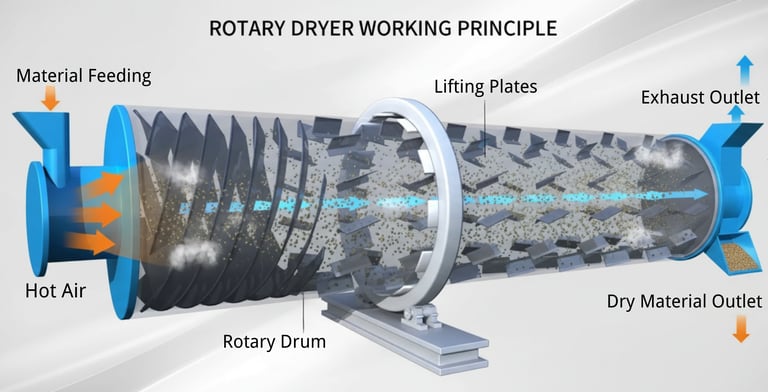

3.Key Differences Between Paddle Dryer and Rotary Dry
Heat Transfer Method
A paddle dryer uses indirect heating, where heat travels through the metal surface from steam or thermal oil. A rotary dryer relies on direct convection from hot gas.
→Paddle dryers are more energy-efficient and environmentally friendly.
Material Handling
Paddle dryers can manage sticky, viscous, and difficult materials. Rotary dryers, on the other hand, require free-flowing solids.
→For sludge or chemical pastes, choose a paddle dryer; for sand or biomass, rotary dryers work best.
Moisture Uniformity
Because paddle dryers mix and heat evenly, they deliver consistent final moisture. Rotary dryers may show slight variation if airflow is uneven.
Energy Efficiency
Indirect heating in paddle dryers minimizes energy loss. Rotary dryers consume more fuel due to direct air heating and exhaust gas.
Maintenance & Cleaning
Paddle dryers are compact and enclosed, easy to clean for hygienic or chemical use. Rotary dryers are larger, requiring longer maintenance intervals.
4.Which Dryer Should You Choose?
If your goal is energy efficiency and precise control, the paddle dryer is the superior choice.
If you handle large volumes of non-sticky materials, a rotary dryer may offer better throughput.
Example – Sludge Drying Case:
When drying industrial sludge, several factors must be evaluated before selecting the right dryer:
Moisture content and viscosity: Sludge typically has high moisture and sticky characteristics, which can easily cause material buildup inside a rotary drum.
Heat sensitivity: Many types of sludge (such as biological or chemical sludge) require gentle, uniform heating to prevent overheating and odor formation.
Energy recovery: Paddle dryers use indirect heating through hollow shafts and jackets, allowing efficient heat transfer and potential reuse of waste heat.
Ease of cleaning and maintenance: The slow-speed agitation of a paddle dryer ensures minimal mechanical wear and easy cleaning between batches.
Therefore, for sludge drying applications, a paddle dryer is generally the more reliable and energy-efficient choice, providing stable operation and consistent final moisture levels.
5.Typical Applications in Different Industries
Both paddle dryers and rotary dryers are widely used across environmental, chemical, food, and biomass industries — but each system excels in different applications.
Here’s how they’re typically applied by manufacturers worldwide, from Asia to Europe and South America.
🌿 Environmental Industry: Sludge & Waste Treatment
Paddle Dryer: Ideal for municipal sludge, industrial wastewater residue, sewage sludge, and organic waste. Its indirect heating and self-cleaning paddles prevent material buildup, making it perfect for sticky or high-moisture content materials.
Rotary Dryer: Commonly used for biomass pellets, animal manure, and lime-treated sludge where large throughput and continuous operation are needed.
⚗️ Chemical Industry: Powders, Pigments & Catalysts
Paddle Dryer: Frequently used to dry pigments, polymers, catalysts, resins, salts, and chemical intermediates that require precise temperature control and gentle mixing.
Rotary Dryer: Better suited for inorganic salts, fertilizers, phosphates, and bulk chemical powders that can handle higher temperatures and fast drying rates.
🍞 Food & Nutritional Industry: Heat-Sensitive Products
Paddle Dryer: Used for yeast, protein concentrate, starch, spices, and flavor powders, where low-temperature drying and hygienic design are critical.
Rotary Dryer: Common for grains, sugar, salt, soybean meal, and other free-flowing food ingredients that require continuous drying at higher volumes.
🪵 Mineral & Biomass Industry: Bulk Solids and Granules
Paddle Dryer: Suitable for fine powders, metal hydroxides, and filter cakes that need uniform drying without dust emission.
Rotary Dryer: Widely applied for sand, limestone, fertilizer granules, coal, and wood chips, thanks to its robust construction and ability to handle large-scale continuous drying.
In general:
Choose a paddle dryer for sticky, paste-like, or heat-sensitive materials.
Choose a rotary dryer for free-flowing, bulk, or high-capacity applications.
Both systems are part of JexDry’s customized drying solutions, designed and manufactured in China and supplied to clients across Southeast Asia, Europe, and the Americas.
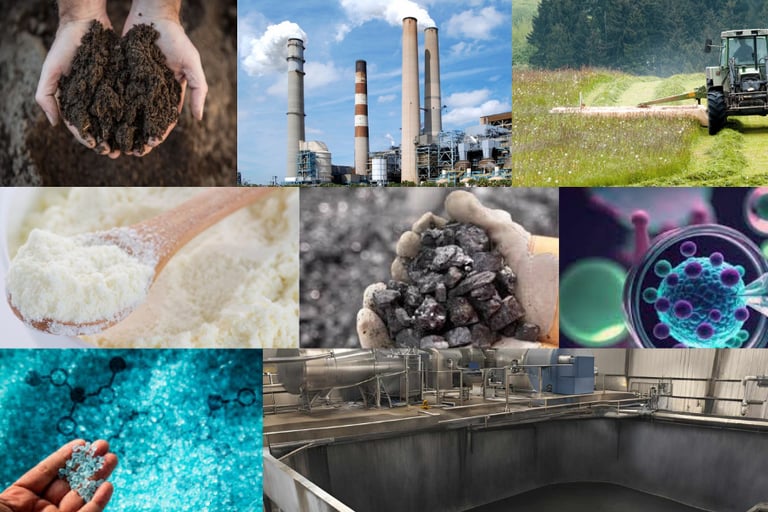

Summary: Choosing the Right Drying Solution
Both paddle dryers and rotary dryers are proven and reliable technologies.
A paddle dryer provides better control, higher efficiency, and cleaner operation, while a rotary dryer excels in capacity and simplicity.
At JexDry, we design and manufacture both paddle dryers and rotary dryers, fully customized to match your material characteristics, moisture content, and production requirements. Whether you are drying sludge, powders, or industrial by-products, our engineering team will help you select the most efficient and cost-effective solution for your process.
If you’re unsure which dryer is right for your application, contact us today — our experts will analyze your material and recommend the best drying system tailored to your needs.
FAQ
What is a paddle dryer?
A paddle dryer is an indirect heating system that uses hollow paddles and a heated jacket to transfer heat through conduction. It’s ideal for drying sludge, pastes, and sticky materials because the slow-moving paddles prevent buildup and ensure uniform drying.
What is a rotary dryer?
A rotary dryer is a direct heating system where hot air flows through a rotating drum, lifting and tumbling the material for fast evaporation. It’s commonly used for powders, granules, and bulk solids that flow freely and can handle higher temperatures.
What is the main difference between paddle and rotary dryers?
The key difference lies in the heat transfer method and material handling.
Paddle dryers use indirect heating for precise temperature control and gentle mixing.
Rotary dryers use direct heating and airflow for large-scale, high-throughput drying.
Which type of dryer is more energy efficient?
Paddle dryers are generally more energy-efficient because they recover heat from the product and exhaust, and minimize heat loss through closed, indirect systems. Rotary dryers, while powerful, often lose more energy through exhaust air.
Which dryer is better for sludge or sticky materials?
For sludge or sticky materials, the paddle dryer is clearly the better choice. Its self-cleaning paddle design and indirect heating prevent clogging and allow continuous, stable drying performance.
When should you choose a paddle dryer over a rotary dryer?
Choose a paddle dryer when your material is viscous, heat-sensitive, or requires precise moisture control. For large-scale drying of free-flowing materials like sand or fertilizers, a rotary dryer may be more suitable.
How do paddle dryers save energy compared to rotary dryers?
Paddle dryers use indirect conduction heating, which transfers energy directly into the material with minimal airflow losses. They can also integrate waste heat recovery systems, reducing overall fuel consumption and improving operational efficiency.
External Links
Learn more about the heat transfer process in industrial dryers — understanding this principle is key to choosing the right drying system for your material.
Studies on energy efficiency in industrial drying systems show how modern designs like paddle dryers can significantly reduce energy consumption compared to traditional rotary dryers.
JexDry is currently showcasing our latest drying solutions at the 67th National Pharmaceutical Machinery Expo in Qingdao — one of China’s largest professional events for the pharmaceutical manufacturing industry.
Our dryers are designed in compliance with Good Manufacturing Practice (GMP) standards in pharmaceutical production to ensure safety, quality, and regulatory reliability for global clients.
About the Author|Expert Contributor
I’m Zar Zha, founder of JexDry and a drying equipment specialist with over 28 years of experience in the industry.
For nearly three decades, my team and I have been dedicated to helping clients around the world solve complex drying challenges across chemical, environmental, food, and biomass industries.
I write these articles to share our technical expertise and to help customers understand how the right drying solution can improve efficiency, reliability, and product quality.
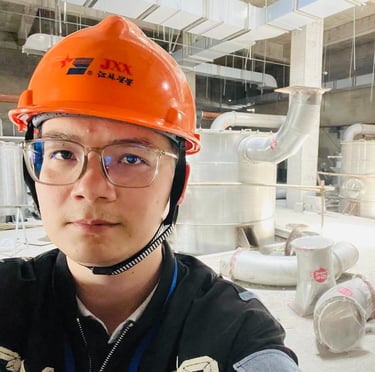

JexDry is a family-run business established in 1998, dedicated to providing customers with the most suitable drying equipment to make their production work more efficient, smooth, and environmentally friendly.
Products
Contact
+86-137-7501-3369
© 2024. All rights reserved.
